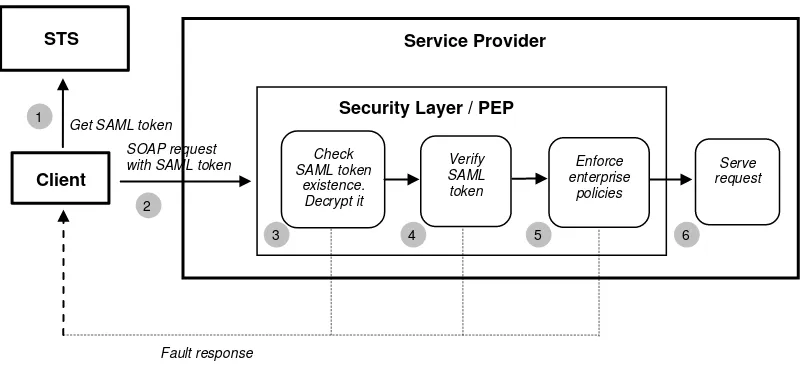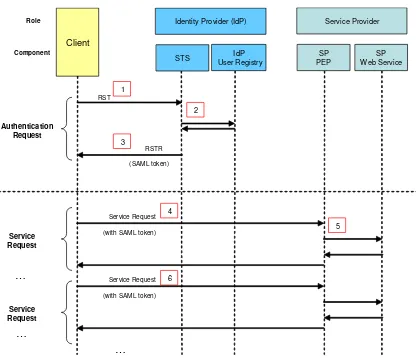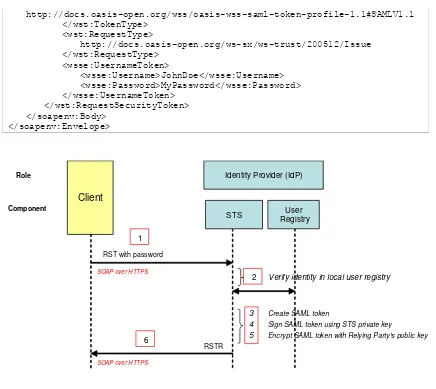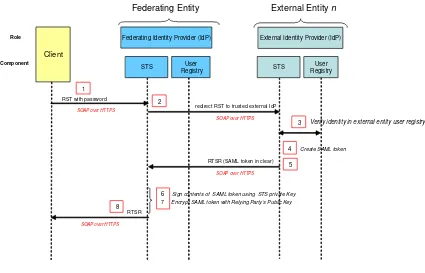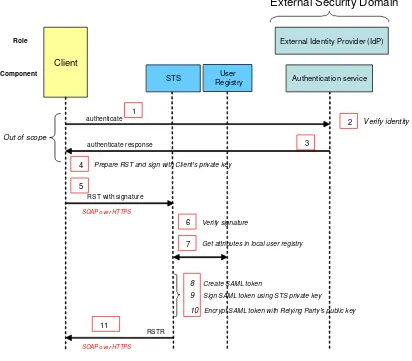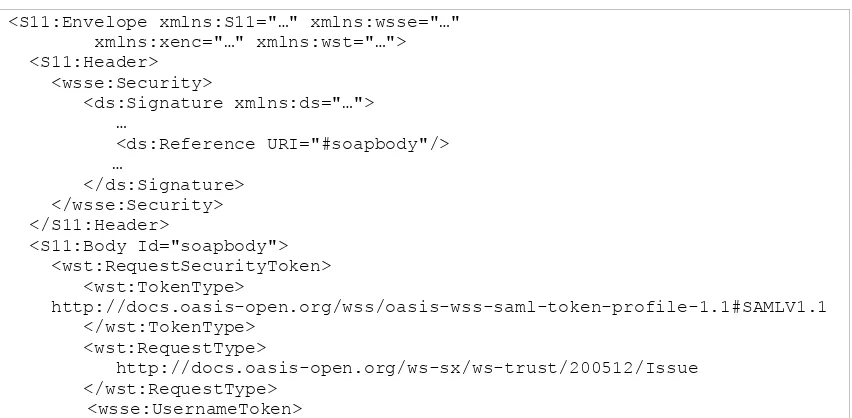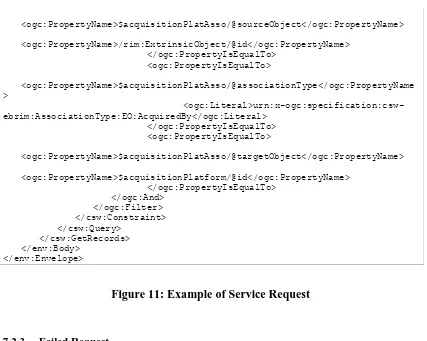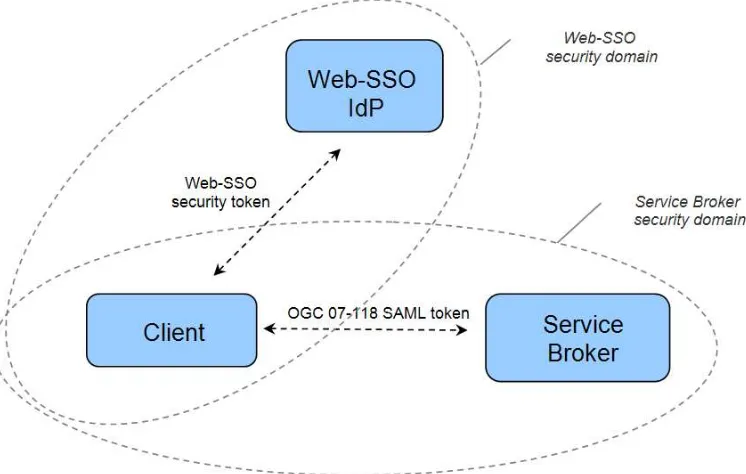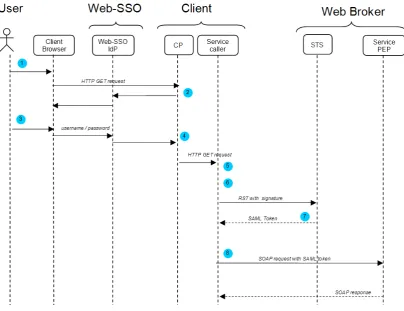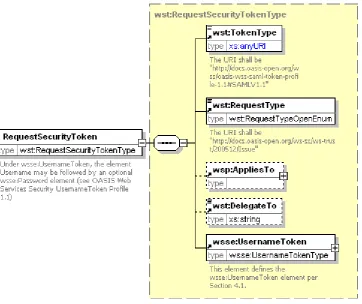Date:
2010-09-08
Reference number of this document:
OGC 07-118r8
Version:
1.0
Category
: OpenGIS
®Best Practice
Editors:
P. Denis, SPACEBEL s.a.
User Management Interfaces for Earth Observation Services
Copyright © 2010 Open Geospatial Consortium, Inc.
To obtain additional rights of use visit http://www.opengeospatial.org/legal/.
Warning
This document is not an OGC Standard. It is distributed for review and
comment. It is subject to change without notice and may not be referred to as an
OGC Standard.
Recipients of this document are invited to submit, with their comments,
notification of any relevant patent rights of which they are aware and to provide
supporting documentation.
Document type:
OpenGIS
®Best Practice
Document subtype:Best Practice
License Agreement
Permission is hereby granted by the Open Geospatial Consortium, ("Licensor"), free of charge and subject to the terms set forth below, to any person obtaining a copy of this Intellectual Property and any associated documentation, to deal in the Intellectual Property without restriction (except as set forth below), including without limitation the rights to implement, use, copy, modify, merge, publish, distribute, and/or sublicense copies of the Intellectual Property, and to permit persons to whom the Intellectual Property is furnished to do so, provided that all copyright notices on the intellectual property are retained intact and that each person to whom the Intellectual Property is furnished agrees to the terms of this Agreement.
If you modify the Intellectual Property, all copies of the modified Intellectual Property must include, in addition to the above copyright notice, a notice that the Intellectual Property includes modifications that have not been approved or adopted by LICENSOR.
THIS LICENSE IS A COPYRIGHT LICENSE ONLY, AND DOES NOT CONVEY ANY RIGHTS UNDER ANY PATENTS THAT MAY BE IN FORCE ANYWHERE IN THE WORLD.
THE INTELLECTUAL PROPERTY IS PROVIDED "AS IS", WITHOUT WARRANTY OF ANY KIND, EXPRESS OR IMPLIED, INCLUDING BUT NOT LIMITED TO THE WARRANTIES OF MERCHANTABILITY, FITNESS FOR A PARTICULAR PURPOSE, AND NONINFRINGEMENT OF THIRD PARTY RIGHTS. THE COPYRIGHT HOLDER OR HOLDERS INCLUDED IN THIS NOTICE DO NOT WARRANT THAT THE FUNCTIONS CONTAINED IN THE INTELLECTUAL PROPERTY WILL MEET YOUR REQUIREMENTS OR THAT THE OPERATION OF THE INTELLECTUAL PROPERTY WILL BE UNINTERRUPTED OR ERROR FREE. ANY USE OF THE INTELLECTUAL PROPERTY SHALL BE MADE ENTIRELY AT THE USER’S OWN RISK. IN NO EVENT SHALL THE COPYRIGHT HOLDER OR ANY CONTRIBUTOR OF INTELLECTUAL PROPERTY RIGHTS TO THE INTELLECTUAL PROPERTY BE LIABLE FOR ANY CLAIM, OR ANY DIRECT, SPECIAL, INDIRECT OR CONSEQUENTIAL DAMAGES, OR ANY DAMAGES WHATSOEVER RESULTING FROM ANY ALLEGED INFRINGEMENT OR ANY LOSS OF USE, DATA OR PROFITS, WHETHER IN AN ACTION OF CONTRACT, NEGLIGENCE OR UNDER ANY OTHER LEGAL THEORY, ARISING OUT OF OR IN CONNECTION WITH THE IMPLEMENTATION, USE, COMMERCIALIZATION OR PERFORMANCE OF THIS INTELLECTUAL PROPERTY.
This license is effective until terminated. You may terminate it at any time by destroying the Intellectual Property together with all copies in any form. The license will also terminate if you fail to comply with any term or condition of this Agreement. Except as provided in the following sentence, no such termination of this license shall require the termination of any third party end-user sublicense to the Intellectual Property which is in force as of the date of notice of such termination. In addition, should the Intellectual Property, or the operation of the Intellectual Property, infringe, or in LICENSOR’s sole opinion be likely to infringe, any patent, copyright, trademark or other right of a third party, you agree that LICENSOR, in its sole discretion, may terminate this license without any compensation or liability to you, your licensees or any other party. You agree upon termination of any kind to destroy or cause to be destroyed the Intellectual Property together with all copies in any form, whether held by you or by any third party.
Except as contained in this notice, the name of LICENSOR or of any other holder of a copyright in all or part of the Intellectual Property shall not be used in advertising or otherwise to promote the sale, use or other dealings in this Intellectual Property without prior written authorization of LICENSOR or such copyright holder. LICENSOR is and shall at all times be the sole entity that may authorize you or any third party to use certification marks, trademarks or other special designations to indicate compliance with any LICENSOR standards or specifications.
This Agreement is governed by the laws of the Commonwealth of Massachusetts. The application to this Agreement of the United Nations Convention on Contracts for the International Sale of Goods is hereby expressly excluded. In the event any provision of this Agreement shall be deemed unenforceable, void or invalid, such provision shall be modified so as to make it valid and enforceable, and as so modified the entire Agreement shall remain in full force and effect. No decision, action or inaction by LICENSOR shall be construed to be a waiver of any rights or remedies available to it.
1 SCOPE ... 7
2 CONFORMANCE ... 8
2.1 CONFORMANCE TO BASE SPECIFICATIONS ... 8
2.2 CONFORMANCE CLASSES ... 8
3 REFERENCES ... 8
3.1 NORMATIVE REFERENCES ... 8
3.2 OTHER REFERENCES ... 10
4 TERMS AND DEFINITIONS ... 11
5 SYMBOLS AND ABBREVIATIONS ... 13
5.1 SYMBOLS (AND ABBREVIATED TERMS) ... 13
5.2 DOCUMENT TERMS AND DEFINITIONS ... 14
6 SYSTEM CONTEXT ... 14
6.1 APPLICATION DOMAIN ... 14
6.2 PROTOCOL BINDING ... 15
6.3 BASIC USE CASES ... 16
6.4 SECURITY MODEL ... 18
6.4.1 Encryption ... 19
6.4.1.1 Retrieval of Encryption Public Key ... 22
6.4.2 Signature / Message Digest ... 23
6.4.3 Authentication Use Cases ... 25
6.4.3.1 STS as local IdP (Default Case) ... 25
6.4.3.2 STS as Federating IdP ... 27
6.4.3.3 STS with trusted IdP ... 29
6.4.4 Service Request ... 31
6.4.5 Extension Points ... 31
6.4.5.1 SAML 2.0 ... 31
7 INTERFACE ... 31
7.1 REQUEST SECURITY TOKEN ... 31
7.1.1 Request ... 32
7.1.2 XML encoding ... 32
7.1.3 Response ... 33
7.1.3.1 Example SAML Token Before Encryption ... 34
7.1.4 Failed Request Security Token ... 36
7.1.5 WSDL ... 36
7.2 SERVICE REQUEST ... 37
7.2.1 Request ... 37
7.2.2 XML encoding ... 37
7.2.3 Failed Request ... 40
7.3 SERVICE RESPONSE... 40
7.3.1 Synchronous Service Response ... 40
7.3.2 Asynchronous Service Response ... 40
8 WEB PORTAL / WEB SERVICE BROKER INTEGRATION... 41
9 SECURITY CONSIDERATIONS ... 44
10 AUTHORISATION USE CASES (NON-NORMATIVE) ... 46
10.1 USES CASE: RESTRICT ACCESS FOR TIME PERIOD ... 46
10.2 USES CASE: ENFORCE RULES FOR SPECIFIC GROUP OF USERS ... 47
10.3 USES CASE: RESTRICT ACCESS TO THE TYPE OF DATA ... 48
10.4 USES CASE: RESTRICT ACCESS TO DATA BASED ON THE AGE OF THE DATA ... 48
10.5 USES CASE: IMPOSING GEOGRAPHICAL CONSTRAINTS ... 49
10.6 USES CASE: ACCESS AND CHECK SOURCE, CONTENT, USER CREDENTIALS AND TIME ... 49
10.7 USES CASE: RESTRICTING ACCESS TO USERS FROM CERTAIN GEOGRAPHIC LOCATIONS. ... 49
ANNEX A: ABSTRACT TEST SUITE (NORMATIVE) ... 51
1 CONFORMANCE TEST CLASS: THE CORE ... 51
1.1 TEST MODULE M.1BASIC REQUIREMENTS ... 51
1.1.1 ATC-1.1 SOAP Binding of the request/response messages ... 51
1.1.2 ATC-1.2 SAML token encoding for authentication information ... 51
1.1.3 ATC-1.3 Encryption algorithm for SAML token ... 52
1.1.4 ATC-1.4 Digest algorithm for signing SAML tokens ... 53
1.2 TEST MODULE M.2RST ... 54
1.2.1 Test Module M.2.1 RST with password ... 54
1.2.1.1 ATC-2.1.1 No request designated IdP - STS resolved as IdP ... 54
1.2.1.2 ATC-2.1.2 STS is request designated Id ... 54
1.2.1.3 ATC-2.1.3 External Entity is request designated IdP ... 55
1.2.1.4 ATC-2.1.4 RST failure ... 55
1.2.2 Test Module M.2.2 RST with signature ... 56
1.2.2.1 ATC-2.2.1 succesful RST with signature ... 56
1.2.2.2 ATC-2.2.2 unsuccesful RST with signature ... 56
1.3 TEST MODULE M.3AUTHORISATION ... 56
1.3.1 ATC-3.1 Authorisation with synchronous response ... 57
1.3.2 ATC-3.2 Authorisation with asynchronous response ... 57
1.3.3 ATC-3.3 Service request failure ... 58
ANNEX B: SCHEMAS (NORMATIVE) ... 59
ANNEX C: SOAP 1.1 IMPLEMENTATION (NORMATIVE) ... 65
ANNEX D: EXAMPLE OF SAML TOKEN ATTRIBUTES SPECIFICATION (NON-NORMATIVE) ... 66
ANNEX E: XACML EXAMPLES (NON-NORMATIVE) ... 67
ANNEX F: EXAMPLE OF WSDL USING WS-POLICY (NON-NORMATIVE) ... 76
Figures
Figure 1 Two cases of authentication ...15Figure 2 Sequence of authentication/authorisation activities ...15
Figure 3 Authentication / Authorisation Use Case ...17
Figure 4 STS - local authentication (Default Case) ...26
Figure 5 STS - external authentication ...28
Figure 6 STS – No authentication ...30
Figure 7: Example of RST with password...32
Figure 8: Example of RST with signature ...33
Figure 9: Example of RST Response ...34
Figure 10: Security Token Service WSDL ...37
Figure 11: Example of Service Request ...40
Figure 12 Web-SSO and Service Broker security domains ...42
Figure 13 Web-SSO / Service Broker integration sequence diagram ...43
Figure 14 RequestSecurityToken schema ...60
i.
Preface
This document describes how user and identity management information may be included in the protocol specifications for OGC Services. The use cases addressed will make reference to EO (Earth Observation) services, for example catalogue access (EO Products Extension Package for ebRIM (ISO/TS 15000-3) Profile of CSW 2.0 [OGC 06-131]), ordering (Ordering Services for Earth Observation Products [OGC 06-141r2]) and programming (OpenGIS Sensor Planning Service Application Profile for EO Sensors [OGC 07-018r2]).
The document was initially produced during the ESA HMA (Heterogeneous Missions Accessibility) project and refined during the FEDEO (Federated Earth Observation) Pilot. It was further refined in the ESA EODAIL and HMA-T projects.
This document is not an OGC standard. This document describes how existing specifications from W3C and OASIS can be used in combination to pass identity information to OGC Web services.
ii.
Submitting organisations
The following organisations will submit the original document or its revisions to the OGCTM Security Working Group.
Spacebel s.a.
ESA – European Space Agency Intecs
STFC
The editors would like to acknowledge that this work is the result of collaboration and review of many organisations and would like to thank for the comments and contributions from:
Astrium Spot Image ASI
Rhea System Oracle Siemens
Note: this does not imply a complete endorsement by these organisations.
iii.
Document contributor contact points
All questions regarding this document should be directed to the editor or the contributors:
Current contributors:
Contact Organisation Email
Pierre Denis Spacebel Pierre.Denis@spacebel.be
Maria-Rosaria Barone Intecs mariarosaria.barone@intecs.it
Stefano Puri Intecs stefano.puri@intecs.it
Andrew Woolf STFC andrew.woolf@stfc.ac.uk
Previous contributors:
Contact Organisation Email
Rowena Smillie Spacebel Rowena.Smillie@spacebel.be
Alexandre Cucumel Spacebel -
Wouter Van de Weghe Oracle wouter.van.de.weghe@oracle.com
iv.
Future work
Formalisation of the WSDL interface using WS-Policy
v.
Foreword
Attention is drawn to the possibility that some of the elements of this document may be the subject of patent rights. The Open Geospatial Consortium Inc. shall not be held responsible for identifying any or all such patent rights.
Introduction
This OGC Best Practice is complementary to a set of OGC Services and related standards and specifications that describe services for managing Earth Observation (EO) data products. These services include collection level, and product level catalogues, online-ordering for archived and to be acquired (future) products, on-line access to these EO products, etc. The application of the current Best Practice is not limited to the Earth Observation domain however, as this document can be considered as a model which could be extended to other OGC application domain and to other bindings beyond the SOAP and HTTP ones described in the following.
The intent of this Best Practice is to describe an identity management interface that can be implemented and supported by many data providers (satellite operators, data distributors …), most of whom have existing (and relatively complex) facilities for the management of their data and users. The proposed strategy is to specify a platform and provider independent interface using existing standards.
1
Scope
This proposed interface document describes the interfaces required to authenticate and authorise users in a federated system of OGC Web Services for Earth Observation. The document has been written with three high level scenarios in mind:
The orchestration of OGC Web Services as it may occur when (e.g.) Sensor Planning Service, Web processing Service and Web Coverage Service are provided by several cooperating organizations.
The system of systems of OGC Web Services as it may occur when several organisations may concur and cooperate in the provision of instances of the same service within a federated service provision. Several relevant use cases are proposed within the GEOSS AIP.
The security and EO products market scenarios which have high level requirements related to the user authentication as well as to the authorisation to the use of the OGC Web Services over geospatial (e.g. area of interest) and/or temporal parameters.
The purpose of this document is to describe how:
HL-REQ010 To perform user authentication (and authorisation) for the use of existing OGC Web Services (i.e. without changes to published OGC standards).
HL-REQ020 To use OASIS and W3C already defined standards for authentication and authorisation of OGC Web Services.
HL-REQ030 To federate different user communities allowing cross authentication for the purpose of using OGC Web Services.
HL-REQ040 To perform authentication and authorisation across orchestrated OGC Web Services.
HL-REQ060 To map an authentication environment based on HTTP binding and Web-SSO (e.g. Shibboleth) with the one based on SOAP and SAML.
Hereafter a brief outline of the document content allows readers to jump directly to the topic of their interest:
the authentication use cases with the use of the SOAP binding is addressed in the chapters 6 and 7;
the mapping of an authentication environment based on HTTP with one based on SOAP as required by HL-REQ060 above is addressed in Chapter 8;
security considerations linking selected threats and risks to proposed countermeasures are addressed in Chapter 9;
the authorisation use case and the possible link with XACML and GEOXACML are addressed in Chapter 10.
2
Conformance
2.1 Conformance to base specifications
This present section describes the compliance testing required for an implementation of this Best Practice.
It is worth highlighting that this OGC document references and uses specifications (SAML, WS Security, XACML) that come from other organizational bodies (such as the Organization for the Advancement of Structured Information Standards - OASIS) for which the concept of “conformance testing” does not apply; consequently, it is not possible to recursively testing the conformance to the compound specifications.
2.2 Conformance classes
We assume that a unique “core” conformance class encompassing all of the specification clauses in the Best Practice is defined and assume that the “Abstract Test Suite” is made up of this unique conformance class (“the core”). This class defines test cases, which covers:
- Test Module Basic requirements
- Test Module Authorisation
These are detailed in the Abstract Test Suite (see Annex A).
3
References
3.1 Normative references
[NR1] W3C Recommendation January 1999, Namespaces In XML, http://www.w3.org/TR/2000/REC-xml-names
[NR2] W3C Recommendation 6 October 2000, Extensible Markup Language (XML) 1.0 (Second Edition), http://www.w3.org/TR/REC-xml
[NR4] W3C Recommendation 2 May 2001: XML Schema Part 1: Structures, http://www.w3.org/TR/2001/REC-xmlschema-1-20010502/
[NR5] W3C Recommendation 2 May 2001: XML Schema Part 2: Datatypes, http://www.w3.org/TR/2001/REC-xmlschema-2-20010502/
[NR6] W3C Simple Object Access Protocol (SOAP) Version 1.1 W3C Note 08 May 2000 , http://www.w3.org/TR/2000/NOTE-SOAP-20000508/
[NR7] WSDL, Web Services Description Language (WSDL) 1.1, http://www.w3.org/TR/wsdl
[NR8] IETF RFC 2119, Keywords for use in RFCs to Indicate Requirement Levels, http://rfc.net/rfc2119.html
[NR9] WS-Security, SOAP Message Security V1.1 http://www.oasis-
open.org/committees/download.php/16790/wss-v1.1-spec-os-SOAPMessageSecurity.pdf
[NR10] SAML, Assertions and Protocol for the OASIS Security Assertion Markup
Language (SAML) V1.1
http://www.oasis-open.org/committees/download.php/3406/oasis-sstc-saml-core-1.1.pdf
[NR11] Web Services Security SAML Token Profile 1.1 http://www.oasis-
open.org/committees/download.php/16768/wss-v1.1-spec-os-SAMLTokenProfile.pdf
[NR12] Secure Hash Standards (SHA-1) National Institute of Standards and Technology http://csrc.nist.gov/cryptval/shs.htm
[NR14] Glossary for the OASIS Security Assertion Markup Language (SAML) http://www.oasis-open.org/committees/security/docs/cs-sstc-glossary-01.pdf
[NR15] Java Cryptography Architecture API Specification & Reference
http://java.sun.com/j2se/1.5.0/docs/guide/security/CryptoSpec.html
[NR16] OGC 04-016r5, OWS Common Implementation Specification 2004/12/17
[NR17] XML encryption http://www.w3.org/TR/xmlenc-core/
[NR18] XML signature http://www.w3.org/TR/xmldsig-core/
[NR19] Apache XML Security http://santuario.apache.org/Java/index.html
[NR20] W3C Recommendation 4 September 2007, Web Services Policy 1.5 - Framework, http://www.w3.org/TR/ws-policy/
[NR21] OASIS eXtensible Access Control Markup Language (XACML) TC
http://www.oasis-open.org/committees/xacml
[NR22] SOAP Version 1.2 Part 1: Messaging Framework (Second Edition), W3C Recommendation 27 April 2007, http://www.w3.org/TR/soap12-part1/
[NR23] OASIS WS-Trust 1.3
http://docs.oasis-open.org/ws-sx/ws-trust/v1.3/ws-trust.pdf
[NR24] OASIS WS-Security UsernameToken Profile 1.1
http://docs.oasis-open.org/wss/v1.1/wss-v1.1-spec-os-UsernameTokenProfile.pdf
[NR25] OGC 07-026r2, Geospatial eXtensible Access Control Markup Language (GeoXACML), 1.0
[NR26] Web Services Federation Language (WS-Federation) Version 1.2
3.2 Other references
[OR1] Shibboleth
4
Terms and definitions
For the purposes of this document, the following terms and definitions apply:
4.1.
Authentication [NR14]
Verification that a potential partner in a conversation is capable of representing a
person or organization
4.2.
circle of trust
A federation of Service Providers and identity providers within which Service
Providers accept the authentication asserted by the identity provider.
4.3.
Claim
A statement made about a client, service or other resource (e.g. name, identity, key,
group, privilege, capability, etc.).
4.4.
client
Software component that can invoke an operation from a server
4.5.
identifier
a character string that may be composed of numbers and characters that is exchanged
between the client and the server with respect to a specific identity of a resource
4.6.
identity provider [NR14]
A kind of Service Provider that creates, maintains, and manages identity information
for principals and provides principal authentication to other Service Providers within a
federation, such as with Web browser profiles.
4.7.
interface
named set of operations that characterise the behaviour of an entity [ISO 19119]
4.8.
operation
specification of a transformation or query that an object may be called to execute [ISO
19119]
4.9.
parameter
variable whose name and value are included in an operation request or response
4.10.
PEP
4.11.
principal [NR14]
A system entity whose identity can be authenticated.
4.12.
Relying Party [NR26]
A Web application or service that consumes Security Tokens issued by a Security
Token Service.
4.13.
request
invocation of an operation by a client
4.14.
response
result of an operation, returned from a server to a client
4.15.
Security Token
A collection of claims. In the present Best Practice, the so-called "SAML token" is a
specific kind of security token where the claims are SAML assertions.
4.16.
Security Token Service
A security token service (STS) is a Web service that issues security tokens.
4.17.
server service instance
a particular instance of a service [ISO 19119]
4.18.
service
distinct part of the functionality that is provided by an entity through interfaces [ISO
19119]
capability which a Service Provider entity makes available to a service user entity at
the interface between those entities [ISO 19104 terms repository]
4.19.
service interface
shared boundary between an automated system or human being and another
automated system or human being [ISO 19101]
4.20.
Service Provider [NR14]
A role donned by a system entity where the system entity provides services to
principals or other system entities.
4.21.
transfer protocol
5
Symbols and abbreviations
5.1 Symbols (and abbreviated terms)
Some frequently used abbreviated terms:
ATS Abstract Test Suite
BPEL Business Process Execution Language
DAIL Data Access Integration Layer
EO Earth Observation
ETS Executable Test Suite
HMA Heterogeneous Missions Accessibility
HTTP HyperText Transport Protocol
IdP Identity Provider
ISO International Organisation for Standardisation
OASIS Advancing Open Standards for the Information Society
OGC Open Geospatial Consortium
PDP Policy Decision Point
PEP Policy Enforcement Point
RST Request Security Token
RSTR Request Security Token Response
SAML Security Assertion Markup Language
SOAP Simple Object Access Protocol
SP Service Provider
SSO Single Sign-On
STS Security Token Service
URI Uniform Resource Identifier
URL Uniform Resource Locator
URN Uniform Resource Name
WSDL Web Service Definition Language
W3C World Wide Web Consortium
XACML eXtensible Access Control Markup Language
5.2 Document terms and definitions
This document uses the specification terms defined in Subclause 5.3 of [NR16].
6
System context
This section documents special requirements and describes the context of use.
6.1 Application domain
Web service requests are received by Service Providers. These Service Providers should be able to identify who issued the request and react accordingly. The following approach is proposed:
1) A Security Token Service (STS) provides a Request Security Token operation (RST), which returns a SAML token, an artefact representing an authenticated user. Depending whether STS is in charge of authentication or not, two main cases are defined:
a. The STS is in charge of authentication: the RST contains user identifier, password and optionally his identity provider. This authentication Web service may federate the identity to another identity provider for authentication. At the interface context this is transparent, the federated identity request being identical to the initial request.
b. The STS is not in charge of authentication, i.e. this is taken in charge by an external IdP, which is trusted by STS: the RST just contains user identifier (no password); it shall be signed in order to check that the requester is trusted.
2) Each subsequent service request by the client (Web service consumer) should include the SAML token in the SOAP header as described later in this document.
3) Each Service Provider accepts service requests only via an Authorisation Service or "Policy Enforcement Point" (PEP). The PEP first checks the existence of SAML token and decrypts it.
4) The PEP verifies the SAML token (signature and expiry time)
5) The PEP decides based on the content of the message body, the contents of the message header (including authentication token) and the context (i.e. applicable policies) whether to accept or to refuse the service request or reroute it. Although this is not imposed, the use of XACML [NR21] or geoXACML [NR25] for definition of policy rules is recommended.
6) If the request is authorised, then the request is processed by the target SP.
If any of the steps from 3) to 5) fails, then a fault response is returned to the client.
Figure 1 Two cases of authentication
These two cases are refined and detailed in section 6.4.3.
The full authentication & authorisation process is detailed in the following figure. This figure highlights the typical sequence of steps from authentication to request authorisation and processing (the two authentication cases are here abstracted).
Figure 2 Sequence of authentication/authorisation activities
6.2 Protocol binding
To provide an overall coherent architecture within this context, operations shall support the embedding of requests and responses in SOAP messages. Only SOAP messaging (via HTTP/POST or HTTPS/POST) with document/literal style shall be used. Messages should conform to SOAP 1.2 [NR22].
For RSTs, the body of SOAP envelope is used. The SOAP header may be used to encapsulate a detached signature (see below).
STS
Client A Service Provider
1a
Get SAML token from user name / password
0
Get SAML token from user name / signature
STS
For service requests, the message payload shall be in the body of the SOAP envelope and the authentication token shall be in the WS-Security element in the header of the SOAP envelope.
6.3 Basic use cases
The use cases covered by this Best Practice are shown in the following sequence diagram:
Authentication: A Request Security Token (RST) is first issued to the Security Token Service (STS).
Authorisation: A service request sent to the Service Provider (SP). This service request is, for instance, a call to any of the operations defined in the catalogue (OGC 06-131), ordering (OGC 06-141) or programming (OGC 07-018) specifications. The service requests can be synchronous or asynchronous via WS-Addressing. This is transparent for the purposes of this Best Practice.
An entity may be either an identity provider (IdP), a Service Provider (SP) or both IdP and SP.
In all the use cases presented in the document, the "Client" is the entity that issues requests to the IdP or SP. It is not the entity running the front-end application used by the human user (e.g. Web browser); this front-end accesses the client of IdP / SP, but is not by itself such client. This remark is especially important for use case relying on "trusted clients" (see 6.4.3.3).
Role
Figure 3 Authentication / Authorisation Use Case
A high level use case for authentication and authorisation is shown in the above figure. Note that the diagram has a higher level of abstraction than the other diagrams present in the remaining of the document; more precisely, the IdP depicted in the figure may either
authenticate users on its own or delegate the authentication to another IdP. The same applies for the depicted SP. Following sections of this document further elaborate the detail of the authentication and authorisation.
1. The RST is sent by the client to the STS, which is directly exposed as a Web service. If required, a request could equally be intercepted by a PEP on IdP and routed to the actual STS (this option however is not followed in the remaining of the document).
2. The IdP performs checks on RST and/or user identity and, if successful, retrieves user attributes; then it sends back an RST Response (RSTR) with SAML token containing assertions on these attributes.
3. The client receives the RSTR containing the SAML token.
4. The client then sends a service request containing the SAML token.
5. The request is received by a PEP that take the decision to authorise or refuse the request, based on the attached SAML token.
It is worth mentioning that authentication request is not directly coupled with subsequent service requests. The client is just in charge of attaching a valid SAML token on each request addressed to PEP-protected SP. The same SAML token can be reused to successfully access several services, provided1
that the PEP of the targeted service is a Relying Party matching the SAML token,
that the SAML token is valid (e.g. expiry time),
that the access policy enforced by the PEP authorises the request.
Based on thes constraints, the actual sequence of authentication requests and service requests is determined by the client, depending on the token renewal algorithm, on the targeted services and on the expiry period of the SAML token defined by the STS.
6.4 Security Model
The model is based on OASIS SAML 1.1 [NR10] 2, WS-Security SAML token profile [NR11] and, for the issuance of SAML token, on OASIS WS-Trust 1.3 [NR23] and OASIS Web Services Security UsernameToken Profile 1.1 [NR24].
For the present need of SAML token delivery, only one operation of WS-Trust 1.3 is
required: the RequestSecurityToken (RST), limited to the "Issue" action, as it is defined in the Issuance Binding section (§4) of [NR23]. This operation returns a
RequestSecurityTokenResponse (RSTR).
The purpose of RST (with "Issue" action) in the present Best Practice is to provide a SAML token to a requester, provided that it gets proof that it can trust this requester. The actual proof of trust depends on which entity is responsible to authenticate users, i.e. which entity is the IdP. The present interface supports two kinds of IdP organisation, which entails two different RST formats:
1. the IdP is the STS (or it can be accessed by the STS): in this case, the RST contains the name and password identifying the user plus an optional definition of the designated IdP; the STS checks that the user can be authenticated with these credentials or relay the authentication to the designated IdP;
2. the IdP is an other system, not accessible by STS: in this case, the RST shall contain a user id and shall be digitally signed: the STS checks that the signature corresponds to a requester that it trusts. For this purpose, the STS shall maintain a list of public keys of all the requester entities it trusts.
Case 1, based on user id/password pair, is the usual pattern that has been covered in all previous versions of the present document. Case 2 has been introduced in version 0.0.6; it allows subcontracting user identification to an external system, which should not be
compliant with the present interface; we mean here SSO systems like OpenSSO, Shibboleth and ESA UM-SSO (see section 8). The context of case 2 is typically a Portal system that assures that a given user has been authenticated and then issues to the STS that trusts this Portal a signed RST with the authenticated user id.
For the ease of description of the differences between the two cases, we shall use in the following the wording RST with password for case 1 and RST with signature for case 2.
1
These elements are detailed and explained in the remaining of the document.
2
In all cases, the returned message is a Request Security Token Response (RSTR), carrying a SAML token (see [NR23]), which contains assertions3 about the authentication and attributes of the identified user.
The STS receives user credentials in SOAP over an encrypted channel i.e. HTTPS. The signed and encrypted SAML token is returned as SOAP over HTTPS and subsequently used in service requests. It is an explicit design decision that the client is unable to decrypt the content of the encrypted SAML token.
6.4.1 Encryption
Encryption of the SAML token is performed by the STS during the processing of RST. Decryption is performed by the PEP during the processing of service request. The encryption protocol is a "hybrid cryptosystem", i.e. it uses together symmetric key encryption and public key encryption. More precisely, it is defined by
a key encapsulation scheme, which is a public-key cryptosystem, and
a data encapsulation scheme, which is a symmetric-key cryptosystem.
From an external point of view, the hybrid cryptosystem is itself a public-key system, which public and private keys are the same as in the key encapsulation scheme. This statement is important for the remaining of the present document where public-key cryptosystem is assumed while symmetric-key encryption aspect is left aside.
The data encryption algorithm used is the AES-128 (symmetric key) while the key encryption is uses RSA (public key), as defined in [NR15]. The full encryption process is as follows:
1. The STS first creates the symmetric key using the AES-128 encryption algorithm.
2. This symmetric key is then itself encrypted with the public key of the entity that shall consume the SAML token using the RSA encryption algorithm to create a secret key.
3. The SAML token (i.e. the SAML Assertion element) is then encrypted with the generated secret key using the AES-128 encryption algorithm. Note that the encryption type is Element, which means that the SAML Assertion element itself is encrypted, not only its child elements; this is specified by the Type attribute of EncryptedData element:
<xenc:EncryptedData xmlns:xenc="http://www.w3.org/2001/04/xmlenc#" Type="http://www.w3.org/2001/04/xmlenc#Element">
4. The message is then built.
The rationale of step 2 is that the SAML token is encrypted for a specific target Service Provider, which can be a Federating SP or not. Only the PEP of the targeted SP is able to decrypt the SAML token, through its private key. The criterion used by IdP to choose the "right" public key will be described in the next subsection (6.4.1.1).
Example Request Security Token with password:
<?xml version="1.0" encoding="UTF-8"?>
3
<soapenv:Envelope xmlns:soapenv="http://schemas.xmlsoap.org/soap/envelope/"
Example Request Security Token with signature:
<S11:Envelope xmlns:S11="…" xmlns:wsse="…"
<S11:Body Id="soapbody"> <wst:RequestSecurityToken> <wst:TokenType>
http://docs.oasis-open.org/wss/oasis-wss-saml-token-profile-1.1#SAMLV1.1 </wst:TokenType>
<wst:RequestType>
http://docs.oasis-open.org/ws-sx/ws-trust/200512/Issue </wst:RequestType>
<wsse:UsernameToken>
<wsse:Username>JohnDoe</wsse:Username> </wsse:UsernameToken>
</wst:RequestSecurityToken> </S11:Body>
</S11:Envelope>
Example Request Security Token Response:
wssecurity-secext-1.0.xsd"
zYoP1665lC7c9TOs8i5OBLM6hGqgEgcKEiTIp+tRUvDEhyN1v/YngT3izvWbsijV0QTTJcjsyFWq
6.4.1.1 Retrieval of Encryption Public Key
The STS shall encrypt the token using the Relying Party‟s public key. This constraint is caused by the public-key encryption of SAML token, which entails that only one defined entity is able to decrypt the delivered SAML token (the one that owns the private key associated to the encrypting public key). In order to afford multiple Relying Parties, the STS shall be able to encrypt the SAML token with one selected public key, chosen among a set of multiple registered public keys.
The target Relying Party is known by the Client of the STS: it is the SP entity to which a service request shall be addressed. This information should be conveyed, from STS Client to STS, on the optional AppliesTo element of the RST, which contains a WS-Address (see Annex B).
The STS shall use a keystore containing at least one default public key and an unlimited set of public keys associated the WS-Address of each Relying Party. The rule used by the STS to choose the public key is then based on the AppliesTo element of the received RST:
• if the AppliesTo element is absent, then the public key used for encryption shall be the default public key registered on the STS;
• if the AppliesTo element is present, then the public key used for encryption shall be the public key of the specific relying party associate to the WS-Address specified in the AppliesTo element; if the WS-Adress is unknown from STS then the RST fails and a fault shall be reported to the requester (see 7.1.4).
6.4.2 Signature / Message Digest
The SAML token is signed before it is encrypted. The signature process is characterized by the following statements:
The secure hash SHA-1 digital signature message digest algorithm is used, as supported by [NR15].
The element that is signed is the top-level SAML Assertion, i.e. <urn:oasis:names:tc:SAML:1.0:assertion:Assertion>.
The signature is put as an "enveloped signature" method, which means that the signature element is embedded as a child of the afore-mentioned SAML Assertion element.
No certificate is put in the signature. This means that the PEP verifying the signature has to know (from its keystore, for example) the public key of the IdP that produced the SAML token.
A canonicalization method shall be used which eliminates namespace declarations that are not visibly used within the SAML token. This shall apply for both
o SignedInfo element, specified in
Signature/SignedInfo/CanonicalizationMethod/@Algorithm
o and actual element to be signed, specified in
Signature/SignedInfo/Reference/Transforms/Transform/@Algorithm
A suitable algorithm is ”Exclusive XML Canonicalization” which is implemented through a digital signature declaration:
Algorithm="http://www.w3.org/2001/10/xml-exc-c14n#"
Note that the specified canonicalization algorithm omits the comments. The URI attribute of the <ds:Reference URI="..."> element shall refer to the
<saml:Assertion> node being signed (using XPointer, see 4.3.3.3 in [NR18]. The XML pattern is as follows:
<saml:Assertion … AssertionID="xxxx" … > …
<ds:Signature …">
<ds:SignedInfo>
…
<ds:Reference URI="#xxxx">
…
</ds:Reference> </ds:SignedInfo>
…
</ds:Signature> </saml:Assertion>
The XPointer format, used in AssertionID and reference URI, shall comply with [NR18]; it is not additionally constrained by the present Best Practice document.
Note that the present Best Practice only enforces the signature of SAML token, which is put in the SOAP body of RSTR and in the SOAP header of service request. Other digital signatures on the remaining elements of SOAP messages, which may be required by
interfaces of Service Providers, are permitted but these are out of the scope of the present Best Practice.
Example: signed token before encryption.
<saml:Conditions NotBefore="2009-06-25T13:33:55Z" NotOnOrAfter="2009-06-25T13:39:55Z"/>
<saml:AuthenticationStatement AuthenticationInstant="2009-06-25T13:34:55Z"
</ds:SignedInfo>
<ds:SignatureValue>oOkdc3KB2HwPB6YzhEa9MHx5yo1u/xqHp81wPj68uf5Ypet/5wHHEvfuN hxD+S3ejT2f4lKIGkVDcsRNyUqaAn60CnJiN4RBpwcjcWQSUj5/XxesaR4nO4CtDylaLV6acLwww lLN5PQ66UumASE=
</ds:SignatureValue> </ds:Signature>
</saml:Assertion>
The security model proposed requires that the case of RST is further decomposed into three cases as described in the following section.
6.4.3 Authentication Use Cases
In the present section, we describe three use cases, which refine the two authentication cases that have been introduced in section 6.1.
The first two use cases assume that the STS is in charge of authentication (case 1.a in 6.1):
1. STS as local IdP: the STS performs authentication from local user registry;
2. STS as Federating IdP: the STS relays authentication request to an external IdP.
The third use case assumes that the STS is not in charge of authentication (case 1.b in 6.1):
3. STS with trusted IdP: the STS does not perform authentication; it delivers security
tokens to trusted clients, which rely themselves on an external, trusted, IdP using another authentication protocol; this case intents to make the present Best Practice interoperable with Web-SSO systems like Shibboleth (see section 8).
These three use cases are detailed in the following subsections.
6.4.3.1 STS as local IdP (Default Case)
In this use case, the RST with password is used; it contains no IdP identifier, so the authentication is performed locally by the STS itself.4
Example:
<?xml version="1.0" encoding="UTF-8"?>
<soapenv:Envelope xmlns:soapenv="http://schemas.xmlsoap.org/soap/envelope/" xmlns:xsd="http://www.w3.org/2001/XMLSchema"
xmlns:xsi="http://www.w3.org/2001/XMLSchema-instance"
xmlns:wsse="http://docs.oasis-open.org/wss/2004/01/oasis-200401-wss-wssecurity-secext-1.0.xsd"
xmlns:wst="http://docs.oasis-open.org/ws-sx/ws-trust/200512/"> <soapenv:Body>
<wst:RequestSecurityToken> <wst:TokenType>
4
http://docs.oasis-open.org/wss/oasis-wss-saml-token-profile-1.1#SAMLV1.1 </wst:TokenType>
<wst:RequestType>
http://docs.oasis-open.org/ws-sx/ws-trust/200512/Issue </wst:RequestType>
<wsse:UsernameToken>
<wsse:Username>JohnDoe</wsse:Username> <wsse:Password>MyPassword</wsse:Password> </wsse:UsernameToken>
</wst:RequestSecurityToken> </soapenv:Body>
</soapenv:Envelope>
Role
Component
RST with password
SOAP over HTTPS
SOAP over HTTPS
3 Create SAML token
5 Encrypt SAML token with Relying Party’s public key
4 Sign SAML token using STS private key
2
Client
1
Identity Provider (IdP)
STS User Registry
Verify identity in local user registry
RSTR
6
Figure 4 STS - local authentication (Default Case)
1. The RST with password is sent to the STS using SOAP over HTTPS.
2. The STS verifies the identity in the local user registry.
3. The STS creates a SAML token using the minimum profile attributes retrieved from the user registry. The SAML token is created containing assertion of the
authentication and assertions regarding the attributes of the user.
4. The STS signs the SAML token using the STS private key.
5. The STS encrypts the SAML token with the Relying Party's public key (see subsection 6.4.1.1 for the process of key retrieval).
6. The RSTR containing the encrypted and signed SAML token is returned to the Client using SOAP over HTTPS.
6.4.3.2 STS as Federating IdP
In the present use case, the RST with password is used; it contains an identifier for the STS of a given external entity n. The STS acts here as a Federating IdP that relies on another IdP to perform the actual authentication. The relation table between identifiers and external entities STS URL shall be stored on the server and configured at service deployment time. It must be done in this way for security as the system must deny access to un-trusted IdP.
Example RST with external IdP specified:
<?xml version="1.0" encoding="UTF-8"?>
<soapenv:Envelope xmlns:soapenv="http://schemas.xmlsoap.org/soap/envelope/" xmlns:xsd="http://www.w3.org/2001/XMLSchema"
xmlns:xsi="http://www.w3.org/2001/XMLSchema-instance"
xmlns:wsse="http://docs.oasis-open.org/wss/2004/01/oasis-200401-wss-wssecurity-secext-1.0.xsd"
xmlns:wst="http://docs.oasis-open.org/ws-sx/ws-trust/200512/"> <soapenv:Body>
<wst:RequestSecurityToken> <wst:TokenType>
http://docs.oasis-open.org/wss/oasis-wss-saml-token-profile-1.1#SAMLV1.1 </wst:TokenType>
<wst:RequestType>
http://docs.oasis-open.org/ws-sx/ws-trust/200512/Issue </wst:RequestType>
<wst:DelegateTo> spot-image </wst:DelegateTo> <wsse:UsernameToken>
<wsse:Username>JohnDoe</wsse:Username> <wsse:Password>MyPassword</wsse:Password> </wsse:UsernameToken>
</wst:RequestSecurityToken> </soapenv:Body>
Role
Component
redirect RST to trusted external IdP
SOAP over HTTPS
RTSR (SAML token in clear)
External Identity Provider (IdP)
7 Encrypt SAML token with Relying Party’s Public Key
6 Sign contents of SAML token using STS private Key
Verify identity in external entity user registry
5
8
SOAP over HTTPS
RTSR
Figure 5 STS - external authentication
1. The RST with password is sent to the STS using SOAP over HTTPS.
2. The STS sees that an identifier of external STS is specified in the RST; it redirects the RST to the designated external IdP (called federated STS in the following). The URL of this IdP is extracted from the table previously described.
3. The federated STS verifies the user in the external entity user registry.
4. The federated STS creates the SAML token using the attributes retrieved from the user profile in the user registry.
5. The RSTR containing the SAML token, in clear, in the SOAP body is returned to Federating STS, through SOAP over HTTPS.
6. The STS signs the SAML token using the Federating STS private key.
7. The STS encrypts the SAML token with the Relying Party's public key (see subsection 6.4.1.1 for the process of key retrieval).
8. The RSTR containing the encrypted SAML token is returned to the Client.
Notes:
1. As for the previous use case, the client is unable to decrypt the content of SAML token present in the received RSTR; only the Relying Party can decrypt the SAML token (using its private key).
2. The confidentiality of the SAML token provided in clear by the external IdP is assured 1° by the HTTPS protocol, which encrypts the SOAP response and 2° by assuring that the requester of the RST is the Federating STS, known in the circle of trust. Actually, about the last point, the rule is:
then the SAML token is returned in clear (present use case)
else the SAML token is encrypted with the
Relying Party's public key (see first use case)
The mechanism to identify the requester as a known Federating STS is left as an implementation decision. This could use WS-Addressing.
The rationale of this process is to support both Clients that access the Federating STS and Clients that access federated STS directly. Also, the system scales up seamlessly in the case of multiple Federating STS : the external STS should simply know a list of authorised Federating STS (instead of a single one) and check inclusion of the
requester in this list.5
6.4.3.3 STS with trusted IdP
We cover here the case where there is an external IdP in an external security domain, which does not comply with the present Best Practice but which is trusted by the STS. This use case is meant to make the present Best Practices interoperable with Web-SSO systems like Shibboleth. For instance, ESA UM-SSO, an SSO system based on Shibboleth, defines a specific security domain with its own IdP (see section 8).
In this present case, the RST with signature is used. (RST contains no password).
In order to integrate such external IdP, a trust relationship shall be established between the two security domain such that any user that has been authenticated by the external IdP shall be able to get the SAML token.
In order to establish a trust relationship between the two security domains, a given Client6C
of external security domain shall provide its public key to the Federated IdP. The trust relationship between C and STS is established as soon as the STS security administrator has registered this public key in the keystore of STS. From that point, the client C can obtain SAML token for any users authenticated on external IdP by issuing RST with signature.
5
Note that several variant mechanisms are feasible, if we allow the inclusion of multiple SAML tokens in the RSTR and/or service requests. A client could then own several tokens for the same user at a given time, encrypted with different public keys and potentially carrying different contents. The PEP should then be given several "chances" (one per included SAML token) to succeed in decryption and to authorise a request. These variant mechanisms change the interfaces defined in the present version of the specification and, therefore, are no more than a subject of investigation.
6
Role
Component
External Security Domain
Client
1
STS RegistryUser
3
External Identity Provider (IdP)
Authentication service
authenticate 2
4
Verify identity
authenticate response
RST with signature
SOAP over HTTPS
SOAP over HTTPS
8 Create SAML token
10 Encrypt SAML token with Relying Party’s public key
9 Sign SAML token using STS private key Get attributes in local user registry
6
RSTR
11
7
Verify signature
Out of scope
5
Prepare RST and sign with Client’s private key
Figure 6 STS
–
No authentication
1. An authentication request is sent to the external IdP (out of scope of the present Best Practice).
2. The external IdP verifies user identity (out of scope of the present Best Practice).
3. The successful authentication response is returned to the Client (out of scope of the present Best Practice).
4. The Client prepares an RST with user id (no password) and signs it with its private key.
5. The RST with signature is sent to the STS using SOAP over HTTPS.
6. The STS verifies the signature of the RTS, based on the set of registered client's public keys (stored beforehand in STS keystore, as trusted Clients); this succeeds.
7. The STS retrieves user attributes from local user registry.
8. The STS creates a SAML token. The SAML token is created containing assertion of the authentication and assertions regarding the attributes of the user.
9. The STS signs the SAML token using the STS private key.
11. The RSTR containing the encrypted and signed SAML token is returned to the Client using SOAP over HTTPS.
6.4.4 Service Request
The service request may contain an encrypted SAML token in the WS-Security element of the SOAP header. This SAML token is obtained from an RST as previously described and is used to control access to services.
N.B. It is not mandatory that the service request is preceded by an RST, as the SAML token is not mandatory in the service request. However, access to services is controlled by the policies applied in the PEP.
Since a specific SAML token protocol is required to access the protected Web Services, the use of WS-Policy [NR20] is recommended for the WSDL files describing these Web services. The WS-Policy elements are used to formally specify the presence of SAML token in SOAP header, the encryption algorithm, etc. With such dispositions, the Web services are self-describing, allowing for "discovery" by clients, hence improving the interoperability of the system. An example of WSDL using WS-Policy is provided in annex F.
The access policies applied in each PEP, based on the SAML token, are out of scope of the present Best Practice. However, to help understanding, several examples of authorisation rules along with their XACML counterparts are provided in section 9.
6.4.5 Extension Points
6.4.5.1 SAML 2.0
This Best Practice uses SAML 1.1 [NR10] as baseline. However, SAML 2.0 will be
supported in the future. To be conservative and backward-compatible, the STS should be able to deliver SAML token formatted in a given SAML version (1.1 or 2.0), specified in the RST. For this purpose, the standard WS-Trust TokenType element of RST shall be used (see schema in Annex B). More precisely, the format of returned token shall be SAML 1.1 or SAML 2.0 depending of the value of TokenType, respectively,
http://docs.oasis-open.org/wss/oasis-wss-saml-token-profile-1.1#SAMLV1.1
or
http://docs.oasis-open.org/wss/oasis-wss-saml-token-profile-1.1#SAMLV2.0
which are standard identifiers specified in SAML Token Profile [NR11].
7
Interface
7.1 Request Security Token
7.1.1 Request
Protocol: SOAP over HTTPS
7.1.2 XML encoding
As explained in 6.4, we make a distinction between RST with password and RST with signature.
The following XML-Schema fragment defines the XML encoding of the message body of the RST with password.
Figure 7: Example of RST with password
The following XML-Schema fragment defines the XML encoding of the message body of the RST with signature.
<S11:Envelope xmlns:S11="…" xmlns:wsse="…"
<S11:Body Id="soapbody"> <wst:RequestSecurityToken> <wst:TokenType>
http://docs.oasis-open.org/wss/oasis-wss-saml-token-profile-1.1#SAMLV1.1 </wst:TokenType>
<wst:RequestType>
http://docs.oasis-open.org/ws-sx/ws-trust/200512/Issue </wst:RequestType>
<wsse:Username>JohnDoe</wsse:Username> </wsse:UsernameToken>
</wst:RequestSecurityToken> </S11:Body>
</S11:Envelope>
Figure 8: Example of RST with signature
7.1.3 Response
The following XML shows an example of response, which is a Request Security Response (RSTR), as defined in WS-Trust 1.3 [NR23], containing an encrypted SAML token. The SAML Token is always encrypted with the Federating Entity public key i.e. in both the use cases the client receives the same response:
the federated response message to the Federating Entity STS and coming from an external Idp.
The federated response message returned by the Federating Entity STS to a client.
<?xml version="1.0" encoding="UTF-8"?>
HtpqP6f+pI4lpkANS4RFxFDiL9Ddxv1WKD//nMck0Su0HfIbPYUYF0GGvlHsv6IiwT8dj/f0MnCx
Figure 9: Example of RST Response
7.1.3.1 Example SAML Token Before Encryption
An example is given here for completeness of the fragment before encryption:
<saml:Assertion xmlns:saml="urn:oasis:names:tc:SAML:1.0:assertion" xmlns="urn:oasis:names:tc:SAML:1.0:assertion"
IssueInstant="2009-06-25T13:34:55Z" Issuer="http://earth.esa.int" MajorVersion="1" MinorVersion="1" >
<saml:Conditions NotBefore="2009-06-25T13:33:55Z" NotOnOrAfter="2009-06-25T13:39:55Z"/>
<saml:AuthenticationStatement AuthenticationInstant="2009-06-25T13:34:55Z"
7.1.4 Failed Request Security Token
If the RST cannot provide the RSTR due to a failure (failed authentication, invalid signature, invalid parameters, resource unavailable, etc), then the SOAP Fault mechanism shall be used, following the recommendation of WS-Trust 1.3 for error handling (see section 11 of [NR23]).
An example is given below, for the case of a failed authentication:
<?xml version="1.0" encoding="UTF-8"?>
<soapenv:Envelope xmlns:soapenv="http://schemas.xmlsoap.org/soap/envelope/" xmlns:wst="http://schemas.xmlsoap.org/ws/2005/02/trust" >
<soapenv:Body> <soapenv:Fault>
<faultcode>wst:FailedAuthentication</faultcode> <faultstring>Authentication failed</faultstring> </soapenv:Fault>
</soapenv:Body> </soapenv:Envelope>
7.1.5 WSDL
The WSDL is given below for the Security Token Service, without the Bindings and Services elements. This WSDL have been obtained by updating reference files from WS-Trust 1.3: http://docs.oasis-open.org/ws-sx/ws-trust/200512/ws-trust-1.3.wsdl
Figure 10: Security Token Service WSDL
7.2 Service Request
The Client can send a service request to a PEP that shall authorise the access to a given service and, if authorised, shall relay this request to the end-point service (e.g. catalogue, programming, ordering services). The request is made using WS-Security containing the SAML token previously returned in the RSTR.
7.2.1 Request
Protocol: SOAP plus WS-Security over HTTP/HTTPS.
7.2.2 XML encoding
The SAML token (i.e. a ds:EncryptionData element extracted from the RSTR) shall be put in the SOAP header of the request, within the WS-Security element.
The following XML fragment defines the XML encoding of an example GetRecords request sent to a catalogue service.
SwbZXgdkgKylqdp0p0FcJVOGb4obfP/6irwzf1ujK2DMJb+9+mTQzfdNIIXimegV5wY2r1Wsg7Xt
resultType="results" service="CSW" startPosition="1" version="2.0.2" xmlns:aoi="http://www.esa.int/xml/schemas/mass/aoifeatures"
xmlns:common="http://exslt.org/common"
xmlns:csw="http://www.opengis.net/cat/csw/2.0.2" xmlns:gml="http://www.opengis.net/gml"
xmlns:rim="urn:oasis:names:tc:ebxml-<ogc:PropertyName>$acquisitionPlatAsso/@sourceObject</ogc:PropertyName>
<ogc:PropertyName>/rim:ExtrinsicObject/@id</ogc:PropertyName> </ogc:PropertyIsEqualTo>
<ogc:PropertyIsEqualTo>
<ogc:PropertyName>$acquisitionPlatAsso/@associationType</ogc:PropertyName >
<ogc:Literal>urn:x-ogc:specification:csw-ebrim:AssociationType:EO:AcquiredBy</ogc:Literal>
</ogc:PropertyIsEqualTo> <ogc:PropertyIsEqualTo>
<ogc:PropertyName>$acquisitionPlatAsso/@targetObject</ogc:PropertyName>
<ogc:PropertyName>$acquisitionPlatform/@id</ogc:PropertyName> </ogc:PropertyIsEqualTo>
</ogc:And> </ogc:Filter> </csw:Constraint> </csw:Query>
</csw:GetRecords> </env:Body>
</env:Envelope>
Figure 11: Example of Service Request
7.2.3 Failed Request
An example is given below:
<?xml version="1.0" encoding="UTF-8"?>
<soapenv:Envelope xmlns:soapenv="http://schemas.xmlsoap.org/soap/envelope/"> <soapenv:Body>
<soapenv:Fault>
<faultcode>AuthorisationFailed</faultcode>
<faultstring>Country of origin not authorised</faultstring> </soapenv:Fault>
</soapenv:Body> </soapenv:Envelope>
7.3 Service Response
7.3.1 Synchronous Service Response
The service response for a synchronous operation is as defined in the service interface, which is detailed for example in the catalogue, ordering or programming specifications.
7.3.2 Asynchronous Service Response
The service response for an asynchronous operation is as defined in the service interface, which is detailed for example in the catalogue, ordering and programming specifications.
If the choice is made to set-up an authentication / authorisation layer for asynchronous service responses, then the response shall be protected by the same encryption and signature as defined for the service request and authentication.
For protocols based on polling, the client and SP keep their initial roles and the use cases are exactly the same than those covered previously.
For protocols based on WS-Addressing, the SP takes the role of the client and conversely. The sequence of steps is as follows:
1. The SP prepares the response to the endpoint mentioned in the WS-Addressing.
2. This response is addressed to the PEP of the SP.
3. The PEP of the SP attaches to the asynchronous response a SAML token authenticating itself as SP. This requires the SP to access an IdP (STS) belonging to the circle of trust, the user registry of the accessed IdP containing an entry that is a surrogate for the SP. For the ease of implementation and integration, it is recommended to have an architecture with one single IdP for the circle of trust. Other architectures with multiple IdP are possible however, including architectures where SP and IdP reside on the same entity.
4. The asynchronous response is returned to the address provided in the WS-Addressing of the request. This will be the address of a PEP that knows the public key of the IdP providing the SAML token attached to asynchronous response, for the purpose of signature verification. If multiple IdP architecture is chosen, then the PEP shall know the set of public keys associated to all these IdP.
8
Web Portal / Web Service Broker Integration
The present section provides specific information to use the present best practices in the context of an integration of a Web-SSO system with a Web service broker. More specifically, it covers the integration of an authentication environment based on HTTP binding (e.g. Shibboleth [OR1]) with the one based on SOAP and SAML (the present document), as expressed in HL-REQ060.
As an exampe of Web-SSO system, UM-SSO is an operational SSO system based on
Shibboleth for ESA Web-based Applications, which could be adopted by other EO Providers as well. It features typical user management functions (login-authentication, registration-account maintenance, access control). It allows ESA Web applications to outsource the sign-on process and offers a given user access to several ESA EO Portals with sign-one single sign-sign-on on his browser.
Figure 12 Web-SSO and Service Broker security domains
In this specific context, a secure bridge shall be established between the two security domains, relying on a trust relationship. RST with signature (see 6.4.3.3) shall be used for that purpose.
Figure 13 Web-SSO / Service Broker integration sequence diagram
1. The user U activates a function on client C, that shall use a Web service broker service
2. The Web-SSO checkpoint on C relays the authentication to the Web-SSO IdP
3. The user U enters his/her credentials and successfully signs on the Web-SSO IdP
4. The Web-SSO checkpoint on C sends a GET request containing Web-SSO-ID in HTTP header
5. The client C prepares an RST with signature, by putting Web-SSO-ID as username and by signing the request.
6. the client Cissues the RST to the service broker‟s STS.
7. The service broker STS verifies the RST signature and returns an encrypted SAML token.
8. The client C issues service request(s) to the Web service broker PEP with encrypted SAML token in SOAP header.
9
Security Considerations
The interface that is presented in the current document was designed according to a specific set of security requirements. Other application domains may want to take additional security measures which are complementary to the minimal interface defined in the current document.
The present section identifies different types of attack or threats that are specific to the present interface; it provides for each of these types of attack or threat the answer or countermeasure, as entailed by the interface. When required, the distinction is made between RSTs and service requests.
Type of attack / threat Answer / countermeasures
Identity Spoofing If the IdP complies with the present Best Practice (see cases 6.4.3.1 and 6.4.3.2), then the sole artefact that conveys user identity, i.e. an evidence of authentication, is the SAML token, obtained by an RST with password. The IdP guarantees that the SAML token for user X
is returned if and only if the credentials of X have been provided (see next threat topics related to password).
If the IdP is an External Entity not complying with the present Best Practice (see case 6.4.3.3), then the threat of identity spoofing has to be analysed at the level of this IdP, as well as the level of security gateway that shall request SAML token to STS. The action of registering the public key of such External entity on the STS means that this STS trusts both external IdP and security gateway. If this is done, then the STS shall serve any RST secured by signature from that security gateway, with no further identity control. The signature verification shall guarantee that the RST that it has been issued by a trusted security gateway and that it has not been tampered with.
For the service requests, the risk is the theft of SAML token, which could be rebound to a new service request issued by a malicious user. This risk is limited by putting short expiry time on SAML token; as the expiry time is part of the SAML token itself, it is protected from changes by signature. The expiry time and signature are both checked by the PEP. Also, HTTPS could be used to avoid (through encryption) the risk of such forged service request. Another countermeasure consists in putting an IP filter to check whether the client is authorised to make service requests.
Man-in-the-middle For RST (with password or with signature): the transport protocol is HTTPS, which is based on SSL; SSL includes a certificate
mechanism to protect against man-in-the-middle attack.
For service requests (if no secured HTTP is used): the signature protocol guarantees that the emitter of SAML token is a trusted IdP and that the token has not been tampered with; this is checked by the PEP. The threat is therefore located on the message payload (SOAP body) or its binding with SAML token. Such threat is analysed in Identity Spoofing, Data integrity, Data confidentiality topics.
Data integrity The signature protocol enforced on SAML Token allows for the verification of its own data integrity, at the PEP level.
The data integrity of the message payload may be checked by another signature mechanism on the SOAP body. Such signature should be bound in some way with the SOAP header, in order to avoid the risk of forged service request (see "identity spoofing" topic).
